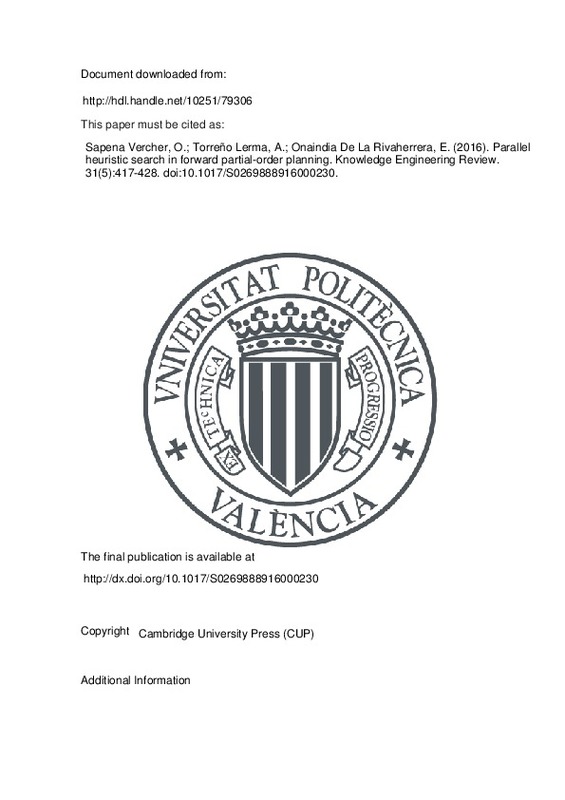JavaScript is disabled for your browser. Some features of this site may not work without it.
Buscar en RiuNet
Listar
Mi cuenta
Estadísticas
Ayuda RiuNet
Admin. UPV
Parallel heuristic search in forward partial-order planning
Mostrar el registro sencillo del ítem
Ficheros en el ítem
| dc.contributor.author | Sapena Vercher, Oscar
|
es_ES |
| dc.contributor.author | Torreño Lerma, Alejandro
|
es_ES |
| dc.contributor.author | Onaindia de la Rivaherrera, Eva
|
es_ES |
| dc.date.accessioned | 2017-03-31T07:37:23Z | |
| dc.date.available | 2017-03-31T07:37:23Z | |
| dc.date.issued | 2016-11 | |
| dc.identifier.issn | 0269-8889 | |
| dc.identifier.uri | http://hdl.handle.net/10251/79306 | |
| dc.description.abstract | [EN] Most of the current top-performing planners are sequential planners that only handle total-order plans. Although this is a computationally efficient approach, the management of total-order plans restrict the choices of reasoning and thus the generation of flexible plans. In this paper, we present FLAP2, a forward-chaining planner that follows the principles of the classical POCL (Partial-Order Causal-Link Planning) paradigm. Working with partial-order plans allows FLAP2 to easily manage the parallelism of the plans, which brings several advantages: more flexible executions, shorter plan durations (makespan) and an easy adaptation to support new features like temporal or multi-agent planning. However, one of the limitations of POCL planners is that they require far more computational effort to deal with the interactions that arise among actions. FLAP2 minimizes this overhead by applying several techniques that improve its performance: the combination of different state-based heuristics and the use of parallel processes to diversify the search in different directions when a plateau is found. To evaluate the performance of FLAP2, we have made a comparison with four state-of-the-art planners: SGPlan, YAHSP2, Temporal Fast Downward and OPTIC. Experimental results show that FLAP2 presents a very acceptable trade-off between time and quality and a high coverage on the current planning benchmarks. | es_ES |
| dc.description.sponsorship | This work has been partially supported by the Spanish MINECO project TIN2014-55637-C2-2-R and cofounded by FEDER. | |
| dc.language | Inglés | es_ES |
| dc.publisher | Cambridge University Press (CUP) | es_ES |
| dc.relation.ispartof | Knowledge Engineering Review | es_ES |
| dc.rights | Reserva de todos los derechos | es_ES |
| dc.subject | Automated planning | es_ES |
| dc.subject | Heuristics | es_ES |
| dc.subject | POP (Partial-Order Planning) | es_ES |
| dc.subject.classification | LENGUAJES Y SISTEMAS INFORMATICOS | es_ES |
| dc.title | Parallel heuristic search in forward partial-order planning | es_ES |
| dc.type | Artículo | es_ES |
| dc.identifier.doi | 10.1017/S0269888916000230 | |
| dc.relation.projectID | info:eu-repo/grantAgreement/MINECO//TIN2014-55637-C2-2-R/ES/GESTION DE METAS PARA AUTONOMIA A LARGO PLAZO EN CIUDADES INTELIGENTES/ | es_ES |
| dc.rights.accessRights | Abierto | es_ES |
| dc.contributor.affiliation | Universitat Politècnica de València. Departamento de Sistemas Informáticos y Computación - Departament de Sistemes Informàtics i Computació | es_ES |
| dc.contributor.affiliation | Universitat Politècnica de València. Escola Tècnica Superior d'Enginyeria Informàtica | es_ES |
| dc.description.bibliographicCitation | Sapena Vercher, O.; Torreño Lerma, A.; Onaindia De La Rivaherrera, E. (2016). Parallel heuristic search in forward partial-order planning. Knowledge Engineering Review. 31(5):417-428. https://doi.org/10.1017/S0269888916000230 | es_ES |
| dc.description.accrualMethod | S | es_ES |
| dc.relation.publisherversion | http://dx.doi.org/10.1017/S0269888916000230 | es_ES |
| dc.description.upvformatpinicio | 417 | es_ES |
| dc.description.upvformatpfin | 428 | es_ES |
| dc.type.version | info:eu-repo/semantics/publishedVersion | es_ES |
| dc.description.volume | 31 | es_ES |
| dc.description.issue | 5 | es_ES |
| dc.relation.senia | 328333 | es_ES |
| dc.identifier.eissn | 1469-8005 | |
| dc.contributor.funder | Ministerio de Economía y Competitividad |







![[Cerrado]](/themes/UPV/images/candado.png)

